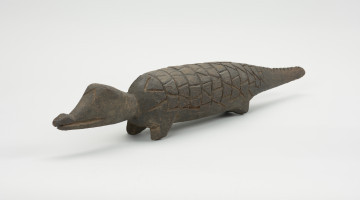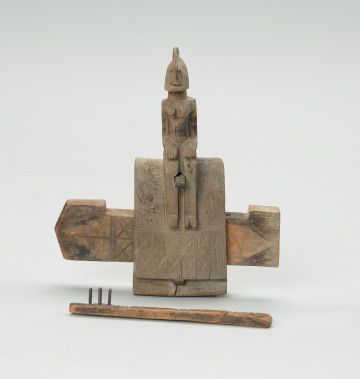
Zoomorphic figurine, figurine of crocodile
między 1951 — 2000
National Museum in Szczecin
Part of the collection: Collection of Dogonian art
The Dogon country is inhabited by a species of short-toed crocodile (Osteolaemus tetraspis) from the crocodile family (Crocodylidae - proper crocodiles), called ayo geu in the language of the Dogon. The crocodile is the protagonist of many stories about the migration of the Dogon to the areas currently inhabited by them. In one of them the crocodile helped to find sacred objects lost during the migration. In another, probably during the crossing of the Niger, the crocodile intervened to get to the other side. Some people tell that their ancestors were rescued from the depths of the water by one huge crocodile, which took a group of people on its back and transported them to the other shore, and then returned several times until it had carried all the Dogon away. In another version of the myth the people were saved by a whole herd of crocodiles. They formed a kind of bridge from their bodies and thus helped everyone to cross safely to the other shore. It is believed that in these stories the Bozo fishermen hide under the figure of the crocodiles and helped the Dogon to reach the Bandiagara Escarpment safely. To this day, a brotherhood exists between the two peoples, i.e. a kind of alliance that is taken very seriously. Marriage between members of these two peoples is treated as incest and, therefore, is strictly forbidden.The short-toed crocodiles, which were still observed in the Sangha region in the 1950s and 1960s, have left their ponds and moved to much more distant rocky hollows. The reason for this state of affairs is the progressive desertification of the Dogon country. Today, crocodiles can only be found in the village of Amani, where they are cared for by humans. The figurine was part of a divination set.
Ewa Prądzyńska
Author / creator
Dimensions
cały obiekt: height: 3,5 cm, width: 2,5 cm
Object type
figure
Creation time / dating
Creation / finding place
Identification number
Location / status

między 1951 — 2000
National Museum in Szczecin

około 1960
National Museum in Szczecin

circa 1970
National Museum in Szczecin
DISCOVER this TOPIC
National Museum in Lublin
DISCOVER this PATH
Educational path